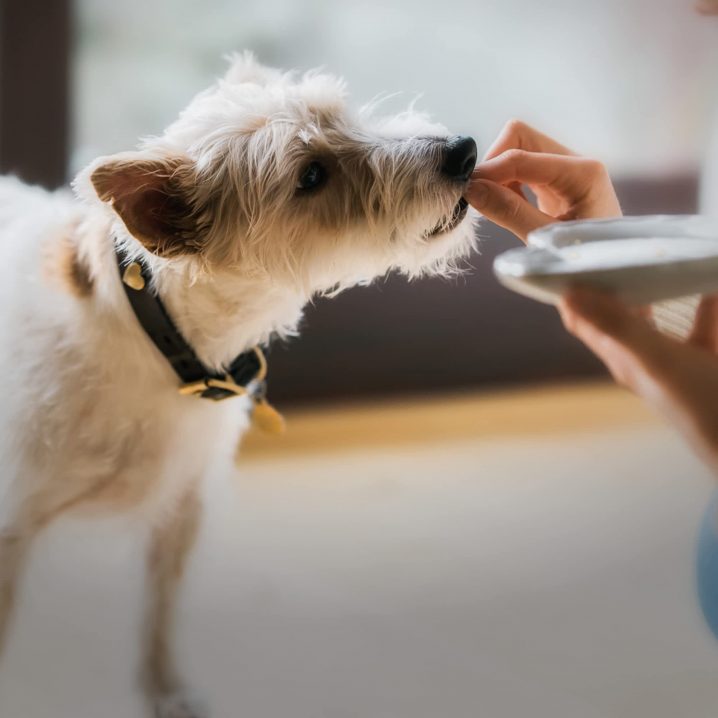
- POPSUGAR Australia
- Living
- Everything You Should Know Before Making Your Own Dog Food, Straight From a Vet
Everything You Should Know Before Making Your Own Dog Food, Straight From a Vet

If you’re a dog owner, you know it’s one of the most rewarding experiences, but it comes with some rather large responsibilities, the most important being determining what food your four-legged friend should be ingesting. Between other duties like proper grooming and exercise, it can be difficult to build a well-balanced food plan. Whether your dog has severe allergies (which may require a more personalized and homemade meal plan) or your pet store is out of stock of your dog’s favorite food, making your own dog food shouldn’t be your first alternative. Why? We have all the info you need from Laura Robinson, DVM, a board-certified veterinarian in California.
First Things First, Are There Downsides to Making Your Own Dog Food?
Robinson highly stressed that you should speak with your veterinarian or a veterinary nutritionist before making changes to your pup’s diet. “Every dog is different and it’s very hard to create a well-balanced diet for your dog with at-home food,” Robinson said. “If done incorrectly, your dog will likely develop micronutrient deficiencies to things like selenium, zinc, or amino acids.” These can affect your dog’s health long-term, so it’s extremely important you don’t start an at-home food plan without first receiving medical advice.
Related: This Is How Much Time You Should Spend With Your Dog, According to Experts
What Foods and Nutrients Are Important For a Dog’s Health?
“Just like humans, dogs need fat, protein, and carbohydrates,” Robinson explained. “In terms of calories, following a 1:1:1 approximate ratio can help build a balanced food plan for your dog.” Proteins like lean chicken or lean turkey, rabbit, goat, or salmon are considered appropriate sources of amino acids. Further, lean meats are easier on the digestive system because of the decrease in fatty meat and protein. Pay attention to carbs like white rice, quinoa, and sweet potatoes and fats like olive oil, corn oil, and walnut oil in both store-bought and homemade recipes.
Can You Make Dog Food That’s Well-Balanced at Home?
If your vet has suggested you try homemade food for your dog, more information on what your pup’s meals should be like should be given to you at your appointment. Robinson advised talking to your vet about websites like Balanceit.com, which offers built-in health guidelines for at-home dog food. “This is a great starting place because as you pick your own meal ingredients, the website will tell you if it’s well-balanced or if changes should be made,” Robinson said. This website in particular is backed up with nutritional information provided by veterinary nutritionists, ensuring you’re feeding your four-legged friend in a healthy and safe manner.
Pet owners should have the same mindset about vitamins and minerals as they do with nutrients and allergies. Robinson recommended discussing multivitamin options with your vet to make sure your pet is getting what they need. Remember, every dog is different, so allergies can vary. “Dogs can be allergic to chicken, beef, fish, eggs, and more, which is why it’s so important to keep a steady eye on what exactly you’re feeding your dog,” particularly if making your own food, Robinson added.
What Are Proper Portion Sizes For Different-Size Dogs?
“The best way to figure a proper portion size for your dog boils down to their size and caloric needs,” Robinson said. “There are standard steps in place that veterinarians follow to compute a dog’s maintenance energy requirements (MER).” Depending on factors like weight loss, weight gain, growth, and if your pet is neutered, size should be adjusted, which is why it’s important to talk to a pro.
Related: What to Do If Your Dog Can’t Stop Digging, According to a Dog Behavior Expert
What Do You Do If Your Pet Has Eaten Something Toxic?
If your pet is used to eating homemade food, keep a close eye on what they get their teeth into. Some of the most common toxic household foods a dog could ingest include chocolate, grapes or raisins, onions, nuts, and citrus. While being aware of your dog’s relationship with these foods is important, it’s even more crucial to understand why they’re toxic. The ASPCA warns that chocolate contains methylxanthines, which can cause vomiting, diarrhea, and excessive thirst. This substance, however, can also be found in coffee and soda. Additionally, dark chocolate puts your pet at an even higher risk.
Grapes and raisins can lead to kidney failure, whereas onions can cause infections in the stomach and intestines. Dr. Robinson strongly urged pet owners to call ASPCA Poison Control if you think your dog has eaten something that may be toxic, and speak with a professional directly.

